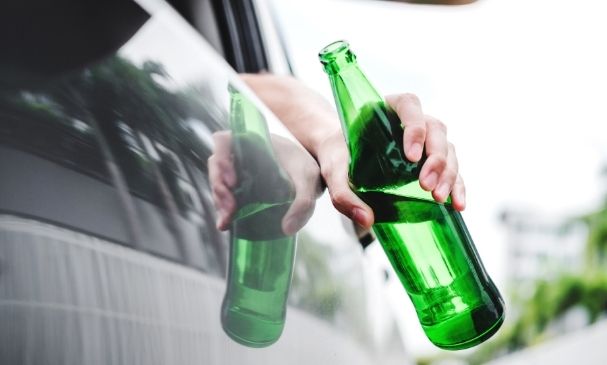The Difference Between Drunk Driving & Drugged Driving

It is prohibited for a driver to operate a vehicle while under the influence of alcohol, drugs, or both drugs and alcohol, according to most state laws. Drunk driving is defined as driving while inebriated with alcohol. Operating a car when intoxicated by drugs or both drugs and alcohol is known as drugged driving.
While both drunk and drugged driving are dangerous, drugged driving outnumbers drunk driving in terms of driver fatalities. The offenses of drunk driving and drugged driving are both covered by most state DUI legislation, but they are not the same. Here are the major differences between drunk and drugged driving.
Differences between Drunk and Drugged Driving
No Legal Limit for Drugged Driving
Most jurisdictions’ DUI statutes clearly indicate that it is illegal for a motorist to operate a vehicle if his or her blood alcohol concentration (BAC) is 0.08 percent or above. This is not the situation, however, with drugged driving, where there is no established legal limit. Experts have never agreed on the quantity of drugs in a driver’s blood that renders him or her incapable of driving. It’s difficult to correlate drug concentration with driving performance. It’s even more difficult because many medicines might impair driving, yet each substance has its own set of consequences.
The majority of state laws solely say that driving while under the influence of drugs, both drugs and alcohol, or while addicted to a drug is banned. It is permissible to drive if you are receiving treatment for a drug addiction in an approved program. There is no legal limit for drugged driving in the legislation.
Testing for Drunk and Drugged Driving
Drunk driving and drugged driving have comparable basic testing processes. A traffic stop is the first step in testing for drug or alcohol intoxication. A traffic stop will be made if a police officer suspects you are inebriated. The police may inquire about your drug or alcohol intake. A PAS (preliminary alcohol testing) test using handheld equipment known as a breathalyzer may be requested by the officer. To ascertain if you are intoxicated, the police may ask you to undertake several field sobriety tests.
Officers also look for physical indicators of intoxication, such as constricted or dilated pupils. If the authorities suspect you are under the influence of narcotics, they may search your vehicle for drug paraphernalia.
You will be charged with drunk driving if the findings of the breathalyzer equipment show that your blood alcohol concentration (BAC) is higher than the legal limit. If your blood alcohol concentration (BAC) is less than 0.08 percent but you still appear intoxicated, it could be a sign that you are under the influence of drugs. It is impossible to establish the number of drugs in your system with a roadside test.
Drug Recognition Expert
When officers rule out alcohol intoxication but still see a driver who looks to be impaired, they may seek the assistance of a drug recognition expert. The specialist will arrive at the DUI arrest scene to assess the driver. The expert may ask the motorist to take a mouth swab test to see if drugs are present in his or her system. A DRE is a law enforcement officer with advanced training. He or she can detect the presence of drugs in a person’s system.
When evaluating to determine if you are indeed intoxicated on drugs, a DRE will:
- Ascertain that your blood alcohol content (BAC) does not indicate alcohol intoxication.
- Interrogate or interview the officer who made the arrest.
- Examine you and search for physical symptoms of drunkenness, such as the size of your pupils, your pulse rate, the presence of drugs in your mouth or nose, your muscular tone, and any injection sites on your body.
- The DRE may administer field sobriety tests such as the one-leg stand test, the finger-to-nose test, the walk-and-turn test, and the Romberg balance test.
- The DRE may also do an eye-tracking examination to look for involuntary eye jerks.
- The expert may initiate a conversation with you about your drug use and examine your reactions.
Blood Test Results for Drugged Driving
In most circumstances, blood testing isn’t required to determine whether or not someone has been drinking and driving. A blood test would be required if a driver is unconscious and unable to submit to drunk driving testing. Blood tests are mostly used in drugged driving tests. A prosecution may introduce the findings of a blood test during a trial for drugged driving.
A toxicological blood test can be used to detect the presence of substances in the circulation. A drug test can also be quantitative to help determine the level or amount of substances identified by a toxicology test. A DRE could testify and report that the amount of drugs in a driver’s system corresponds to his or her level of impairment.
No Correlation Between the Presence of Drugs and Intoxication
There is a link between the amount of alcohol in one’s system and the level of intoxication when it comes to drunk driving. In drugged driving, however, this is not the case. The presence of drugs in a person’s system does not necessarily indicate that they are impaired.
Drugs affect different people in different ways, and some people will be more affected than others. After consuming medications for a long time, some people acquire a tolerance to them. As a result, persons who use drugs frequently may show fewer indicators of impairment than people who use seldom drugs.
We hope you have found our article on the differences between drunk driving and drugged driving helpful. If you have already been deemed a high-risk driver and need FR44 auto insurance, be sure to reach out to Serenity Group! We are dedicated to ensuring that the insurance buying process for high-risk drivers is as easy and fast for you as possible!


Recent Comments